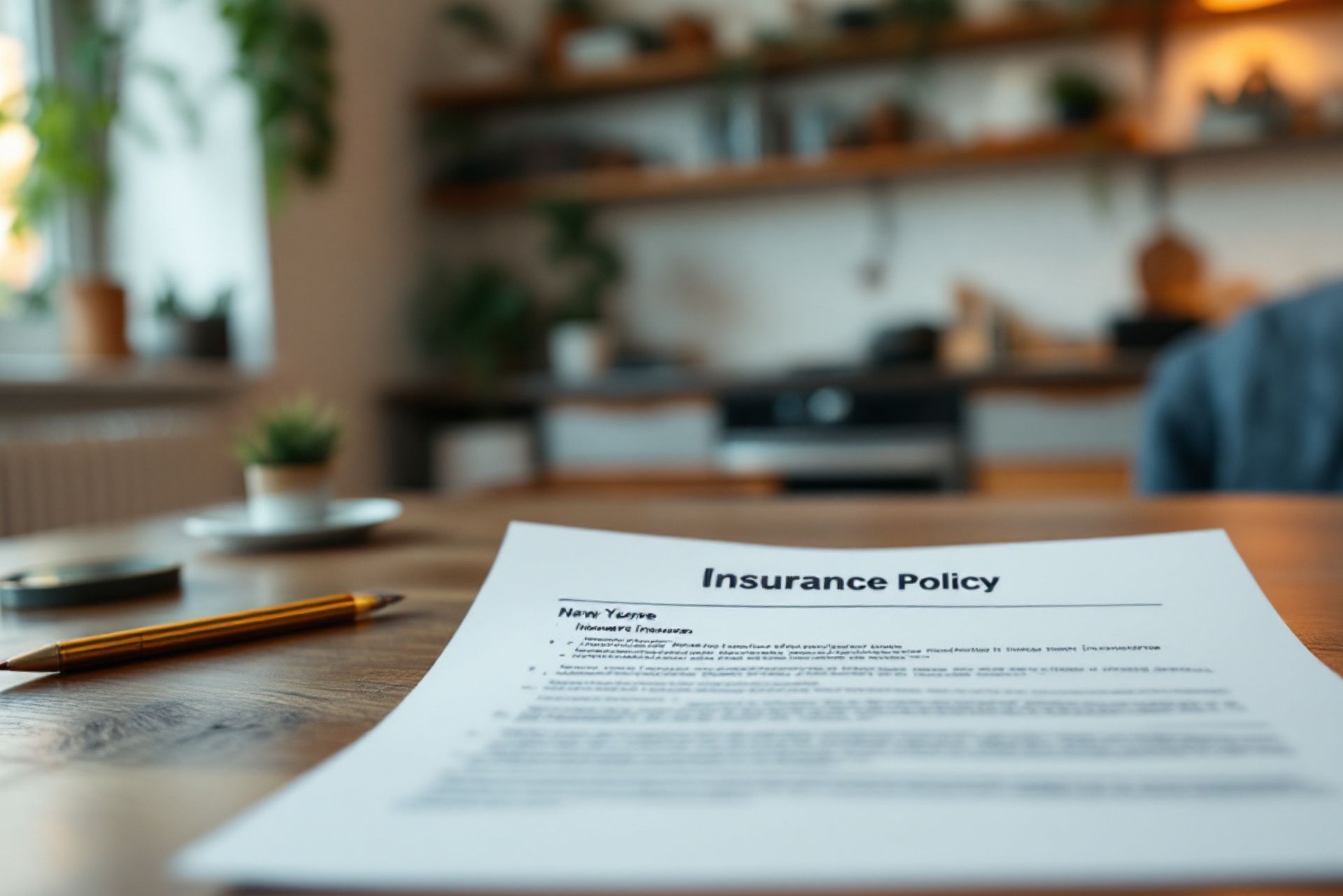
Most Common Personal Policies
Index
Contact Us
Homeownership in New York comes with its set of responsibilities and, notably, risks. One of the most significant risk management strategies for homeowners is obtaining a suitable home insurance policy. This article delves deep into the specifics of New York home insurance, including policy types, costs, and more.
Understanding Home Insurance Basics
Before diving into the specifics of home insurance in New York, it’s vital to grasp the fundamentals. Home insurance is a type of property insurance that provides financial protection against damages or losses to residential properties. It covers both the structure of the home and the belongings inside.
What is Home Insurance?
Home insurance serves as a financial safety net for homeowners. It typically covers losses from certain perils such as fire, theft, vandalism, and certain natural disasters. Additionally, it usually includes liability protection, which offers coverage in case someone gets injured on your property.
Understanding how your home insurance policy operates is crucial for effective coverage. Policies may vary in their coverage limits, deductibles, and premiums. Knowing what is included can help you avoid unexpected expenses during a claim. For instance, some policies may cover replacement costs for damaged items, while others may only offer actual cash value, which takes depreciation into account. This distinction can significantly impact the amount you receive in a claim, making it essential to read the fine print and ask questions when necessary.
Why is Home Insurance Important?
Home insurance is essential for several reasons. First and foremost, it protects one of your most significant investments—the place you call home. Without insurance, paying for repairs or rebuilding after a disaster could be financially devastating.
Furthermore, most mortgage lenders require home insurance as part of the loan agreement. In essence, it provides peace of mind. With a sound policy in place, homeowners can rest easier knowing they’re covered against unpredictable events. Additionally, home insurance can also cover additional living expenses if your home becomes uninhabitable due to a covered loss. This means that if you need to temporarily relocate while repairs are being made, your policy may help pay for hotel stays and meals, alleviating the financial burden during an already stressful time. Understanding these nuances can empower homeowners to make informed decisions about their coverage and ensure they are adequately protected in times of need.

The Specifics of New York Home Insurance
New York has unique factors that influence home insurance, such as its geographical risks, state regulations, and the overall housing market. Understanding these specifics will help you make informed decisions regarding coverage.
New York Home Insurance Laws and Regulations
In New York, home insurance policies are regulated by the New York State Department of Financial Services. These regulations dictate the terms and conditions that insurance providers must follow, offering consumers a level of protection and transparency.
For example, insurance companies must clearly disclose their coverage options and exclusions, ensuring homeowners are fully informed before purchasing a policy. It's also necessary for insurers to file their rates with the department, allowing for oversight on pricing and practices. Furthermore, New York law mandates that insurers provide a written explanation of any policy changes, giving homeowners the opportunity to understand how alterations may impact their coverage and premiums.
Additionally, New York has specific provisions for homeowners facing financial hardships, such as the ability to request a payment plan or deferment options. This is particularly important in a state where economic fluctuations can affect many residents, ensuring that homeowners can maintain their coverage even during challenging times.
Average Cost of Home Insurance in New York
The cost of home insurance in New York varies widely based on several factors, including location, home value, and the extent of coverage chosen. On average, homeowners can expect to pay between $1,000 and $2,000 per year for a standard homeowners insurance policy.
Urban areas, especially those prone to natural disasters or higher crime rates, may see rates on the higher end, while rural locations may offer more affordable options. It’s also wise to consider additional factors like the age of the home and the presence of safety features such as security systems. Moreover, homeowners in flood-prone areas, particularly in regions like Long Island or along the Hudson River, may need to purchase separate flood insurance, which can significantly increase overall insurance costs.
Another important aspect to consider is the impact of the local housing market on insurance rates. In neighborhoods where home values are rapidly increasing, insurance premiums may rise correspondingly to reflect the higher replacement costs. Homeowners should regularly review their policies to ensure that their coverage aligns with current market conditions and property values, as underinsurance can lead to significant financial losses in the event of a disaster.
Types of Home Insurance Policies in New York
Understanding the different types of home insurance policies available can help homeowners choose the best coverage for their specific needs. In New York, various options cater to different risk profiles and coverage preferences.
Comprehensive Home Insurance
Comprehensive home insurance, often known as an HO-5 policy, offers extensive coverage for both the home structure and personal belongings. It protects against a wide array of perils and includes liability coverage, making it a well-rounded option for many homeowners.
This type of policy is ideal for individuals looking for maximum protection, as it provides a broader range of coverage than standard options. Buyers should review the specifics of what is included, ensuring it meets their needs. Additionally, many comprehensive policies may offer endorsements for valuable items such as jewelry or art, which can provide extra peace of mind for those with significant assets. Homeowners should also inquire about any discounts available for bundling policies or for having security systems in place, as these can significantly reduce premiums.
Dwelling Insurance
Dwelling insurance primarily covers the physical structure of your home. This policy is crucial for those who might want to keep their coverage focused primarily on the home itself, particularly landlords who rent out properties.
While dwelling insurance may not cover personal belongings, it typically protects against perils such as fire, wind, and hail damage. It’s important for policyholders to clarify exclusions and limitations when choosing this type of insurance. Furthermore, landlords should consider additional coverage options, such as loss of rent insurance, which can help mitigate income loss during periods when the property is uninhabitable due to covered damages. Understanding local building codes and requirements can also influence the type of dwelling insurance needed, ensuring compliance and adequate protection.
Liability Coverage
Liability coverage is a critical component of any home insurance policy, protecting homeowners from legal claims resulting from injury or property damage to others. It helps cover legal fees, medical expenses, and damages awarded in lawsuits.
In New York, where litigation can be a serious concern, ensuring you have adequate liability coverage is essential. Homeowners should assess their risk factors and consider higher coverage limits if they regularly host guests or have shared community spaces. Additionally, it may be wise to explore
umbrella insurance policies, which provide an extra layer of liability protection beyond standard home insurance limits. This can be particularly beneficial for homeowners with substantial assets to protect, as it can safeguard against larger claims that could otherwise jeopardize financial stability. Understanding the nuances of liability coverage can empower homeowners to make informed decisions that align with their lifestyle and risk exposure.
How to Choose the Right Home Insurance in New York
Choosing the right home insurance is a crucial process that requires careful consideration of various factors that affect coverage and costs. Here are some tips to help New Yorkers make informed choices.
Assessing Your Home Insurance Needs
Start by evaluating the value of your home and belongings. Understanding what you need to cover—such as your house’s replacement cost and the total value of personal possessions—will provide a foundation for selecting the appropriate policy.
Additionally, consider your financial situation. Higher deductibles generally lead to lower premiums but can be risky during claims. Make sure to balance your comfort level with potential out-of-pocket expenses. It’s also wise to think about the unique risks associated with living in New York, such as natural disasters like hurricanes or flooding, which may necessitate additional coverage options beyond standard policies.
Comparing Home Insurance Quotes
Once you have determined your needs, comparing quotes from multiple insurance providers is the next step. Obtain quotes and look beyond merely the premiums; policies with lower costs may offer inferior coverage.
- Compare coverage options and policy limitations.
- Check the financial stability and customer service reputation of each insurer.
- Take advantage of any discounts for bundling policies or for having safety features in place.
This thorough comparison process can uncover significant differences between providers and policies, allowing homeowners to make the best choice for their needs. Furthermore, consider reaching out to a local insurance agent who understands the New York market; they can provide tailored advice and insights that online research may not reveal. Engaging with an expert can also help clarify any complex terms or conditions in the policy, ensuring that you fully understand what you are purchasing.
Lastly, don’t forget to review your policy annually or after significant life changes, such as renovations or acquiring new valuables. Home insurance is not a one-size-fits-all solution, and as your circumstances evolve, so should your coverage. Regularly reassessing your policy can help you stay protected and potentially save money by adjusting your coverage to better fit your current needs.

Filing a Home Insurance Claim in New York
Even with robust insurance policies, homeowners may find themselves needing to file a claim at some point. Understanding the claims process can reduce stress during these often-challenging times.
Steps to File a Claim
When filing a home insurance claim in New York, follow these steps:
- Report the incident promptly to your insurance provider.
- Document the damage thoroughly with photos or videos.
- Complete any necessary claim forms, typically available on your insurer’s website.
- Communicate with an insurance adjuster to assess the damage and determine the payout amount.
Being organized and proactive can streamline the process and help ensure that your claim is processed efficiently. Additionally, it may be beneficial to keep a detailed log of all communications with your insurer, including dates, times, and the names of representatives you speak with. This record can serve as a valuable reference if any disputes arise during the claims process.
What to Expect After Filing a Claim
Once your claim has been submitted, expect communication from your insurer regarding the next steps. This may involve personal visits from adjusters to examine the damage or conduct interviews regarding the incident. It’s important to prepare for these visits by having all relevant documentation readily available, including your policy details and any previous correspondence related to the claim.
Keep in mind that the timeline for receiving compensation can vary. It’s essential to maintain open lines of communication with your insurer for updates and further questions during this period. In some cases, the adjuster may require additional information or clarification, which can prolong the process. Being responsive and providing the requested information promptly can help expedite the resolution of your claim. Moreover, understanding your policy’s coverage limits and exclusions will empower you to have informed discussions with your insurer, ensuring that you receive the compensation you are entitled to.
Frequently Asked Questions about New York Home Insurance
As homeowners navigate the intricacies of home insurance in New York, several common questions arise regarding eligibility, coverage, and services offered. Here are answers to some frequently asked queries.
Can I Get Home Insurance with a Bad Credit Score?
Yes, you can still get home insurance with a bad credit score, although it may come with higher premiums. Many insurers view credit scores as a risk factor and may adjust their rates accordingly.
It's advisable to compare rates from different companies, as some may be more flexible regarding credit history and might offer better options for those with lower scores. Additionally, improving your credit score over time can lead to lower premiums. Simple steps such as paying bills on time, reducing debt, and regularly checking your credit report for errors can help you enhance your creditworthiness and potentially lower your insurance costs in the future.
Does Home Insurance Cover Natural Disasters?
Home insurance coverage for natural disasters varies by policy and the specific disaster in question. For example, standard policies often cover damage from fire, windstorm, and hail, but may not include coverage for floods or earthquakes.
Homeowners in areas prone to these risks might need to consider additional insurance, such as flood insurance or a separate earthquake policy. Always review your coverage with your insurer to ensure you have the protection needed against natural disasters. Furthermore, understanding the specific risks associated with your geographic location can help you make informed decisions about the types of coverage you may need. For instance, New York homeowners in coastal areas may face unique challenges related to hurricanes and flooding, necessitating tailored coverage options to adequately protect their homes and belongings.
In addition to understanding the types of coverage available, it's also important to be aware of the claims process in the event of a disaster. Knowing what documentation is required and how to file a claim can expedite the process and ensure that you receive the compensation you need to recover from unexpected events. Engaging with your insurance agent to clarify these details can provide peace of mind and help you feel more prepared for any potential challenges that may arise.
